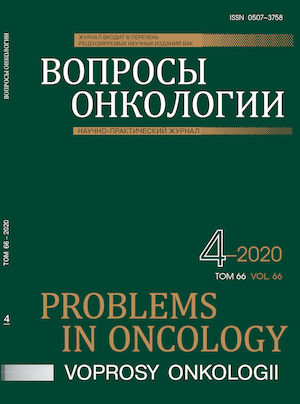摘要
Целью исследования явилось изучение аноректальной функции при помощи аноректальной манометрии высокого разрешения у пациентов, перенесших комбинированное лечение по поводу рака прямой кишки. Материал и методы. Проведен анализ данных литературы (использовались базы данных PubMed, Scopus, eLIBRARY) и собственных результатов лечения 50 больных раком прямой кишки, которым проведено комбинированное и хирургическое лечение в ФГБУ «Ростовский научно-исследовательский онкологический институт» МЗ РФ. Результаты исследования. Среднее анальное давление покоя было в 1,8 раза ниже, максимальное анальное давление сжатия было в 1,5 раза ниже у пациентов после комбинированного лечения, чем после хирургического (р<0,05). Через 3 мес. после комбинированного лечения пациентов с применением пролонгированной лучевой терапии сократительная способность внутреннего сфинктера была снижена у 83,3% больных; наружного сфинктера - у 26,7% больных. Утомляемость мышц наружного сфинктера была повышена у 17 больных (56,7%) этой группы. Нами была обнаружена корреляция некоторых данных аноректальной манометрии и шкалы LARS. Так, у пациентов обеих групп с максимальным числом баллов шкалы LARS наблюдалось наименьшее среднее анальное давление покоя по сравнению с пациентами с минимальными и средними значениями шкалы LARS (р<0,05). Заключение. В связи с негативным влиянием лучевой терапии на аноректальную функцию, в настоящее время важным представляется как тщательный отбор для лучевой терапии именно тех пациентов, которые получат от нее пользу, так и выявление пациентов с высоким риском развития функциональных проблем после лучевой терапии, а также разработка реабилитационных программ для пациентов, получивших лечение по поводу рака прямой кишки.
参考
Шелыгин Ю.А., Фоменко О.Ю., Титов А.Ю., Веселов В.В., Белоусова С.В., Алешин Д.В. Сфинктерометрические показатели давления в анальном канале в норме. Колопроктология. 2016; №2(56): 32-36.
Парфенов А.И., Карлов А.В., Индейкина Л.Х., Мясникова Е.М. Методика проведения и клиническое значение аноректальной манометрии при заболеваниях кишечника. Методические рекомендации. М., 2015. 20с.
Yoo S.Y, Bae K.S., Kang S.J. et al. How important is the role of the internal anal sphincter in fecal continence? An experimental study in dogs. J. Pediatr. Surg. - 1995. - 30. - 5. - 687-91.
Rao S.S., Welcher K.D., Leistikow J.S. Obstructive defecation: a failure of rectoanal coordination. Am. J. Gastroenterol. 1998; 93(7): 1042-50.
Rao S.S., et al. Ambulatory 24-hour colonic manometry in slowtransit constipation. Am. J. Gastroenterol. 2004;99(12):2405-16.
Pandolfino J.E., Ghosh S.K., Rice J., Clarke J.O., Kwiatek M.A., Kahrilas P.J. Classifying esophageal motility by pressure topography characteristics: a study of 400 patients and 75 controls. Am. J. Gastroenterol. 2008; 103(1):27-37.
Lee Y.Y., Erdogan A., Rao S.S. High resolution and high definition anorectal manometry and pressure topography: diagnostic advance or a new kid on the block? Curr. Gastroenterol. Rep. 2013; 15(12): 360.
Кит О.И., Геворкян Ю.А., Гусарева М.А., Розенко Л.Я., Солдаткина Н.В., Харагезов Д.А., Белецкий Г.Л. Преимущества короткого и пролонгированного курса предоперационной лучевой терапии в лечении рака прямой кишки. Вопросы онкологии. 2018; 64 (1): 110-115.
Кит О.И., Геворкян Ю.А., Солдаткина Н.В., Харагезов Д.А., Милакин А.Г., Дашков А.В., Егоров Г.Ю., Каймакчи Д.О. Конверсия лапароскопического доступа в хирургии колоректального рака. Хирургия. Журнал им. Н.И. Пирогова. 2019; 3: 32-41.
Кит О.И., Геворкян Ю.А., Солдаткина Н.В., Гусарева М.А., Харагезов Д.А., Милакин А.Г, Ильченко С.А. Полный клинический ответ рака прямой кишки на химиолучевое лечение: тактика. Вопросы онкологии. 2017; 63 (6): 838-842.
Marijnen C.A., van de Velde C.J., Putter H., et al. Impact of short-term preoperative radiotherapy on health-related quality of life and sexual functioning in primary rectal cancer: report of a multicenter randomized trial. J. Clin. Oncol. 2005; 23: 1847-1858.
Ekkarat Р.А., Boonpipattanapong Т.А., Tantiphlachiva K., Sangkhathat SA Factors determining low anterior resection syndrome after rectal cancer resection: A study in Thai patients. Asian Journal of Surgery. 2016; Volume 39, Issue 4: 225-231.
Ammann K., Kirchmayr W., Klaus A., et al. Impact of neoadjuvant chemoradiation on anal sphincter function in patients with carcinoma of the midrectum and low rectum. Arch Surg. 2003; 138: 257-261.
Canda A.E., Terzi C., Gorken I.B., et al. Effects of preoperative chemoradiotherapy on anal sphincter functions and quality of life in rectal cancer patients. Int. J. Colorectal. Dis. 2010; 25: 197-204.
Ihnt P., Slvov I., Tulinsky L., Rudinsk L.I., M ca J., Penka I. Anorectal dysfunction after laparoscopic low anterior rectal resection for rectal cancer with and without radiotherapy (manometry study). J. Surg. Oncol. 2018;117:710-716.
Matzel K.E., Bittorf B., Gunther K., et al. Rectal resection with low anastomosis: functional outcome. Colorectal. Dis. 2003; 5: 458-464.
Rahbari N.N., Elbers H., Askoxylakis V., et al. Neoadjuvant radiotherapy for rectal cancer: meta-analysis of randomized controlled trials. Ann. Surg. Oncol. 2013; 20: 4169-4182.
Lim J.F., Tjandra J.J., Hiscock R., et al. Preoperative chemoradiation for rectal cancer causes prolonged pudendal nerve terminal motor latency. Dis. Colon Rectum. 2006; 49: 12-19.
Lundby L., Krogh K., Jensen V.J., et al. Long-term anorectal dysfunction after postoperative radiotherapy for rectal cancer. Dis. Colon Rectum. 2005; 48: 1343-1352.

This work is licensed under a Creative Commons Attribution-NonCommercial-NoDerivatives 4.0 International License.
© АННМО «Вопросы онкологии», Copyright (c) 2020
